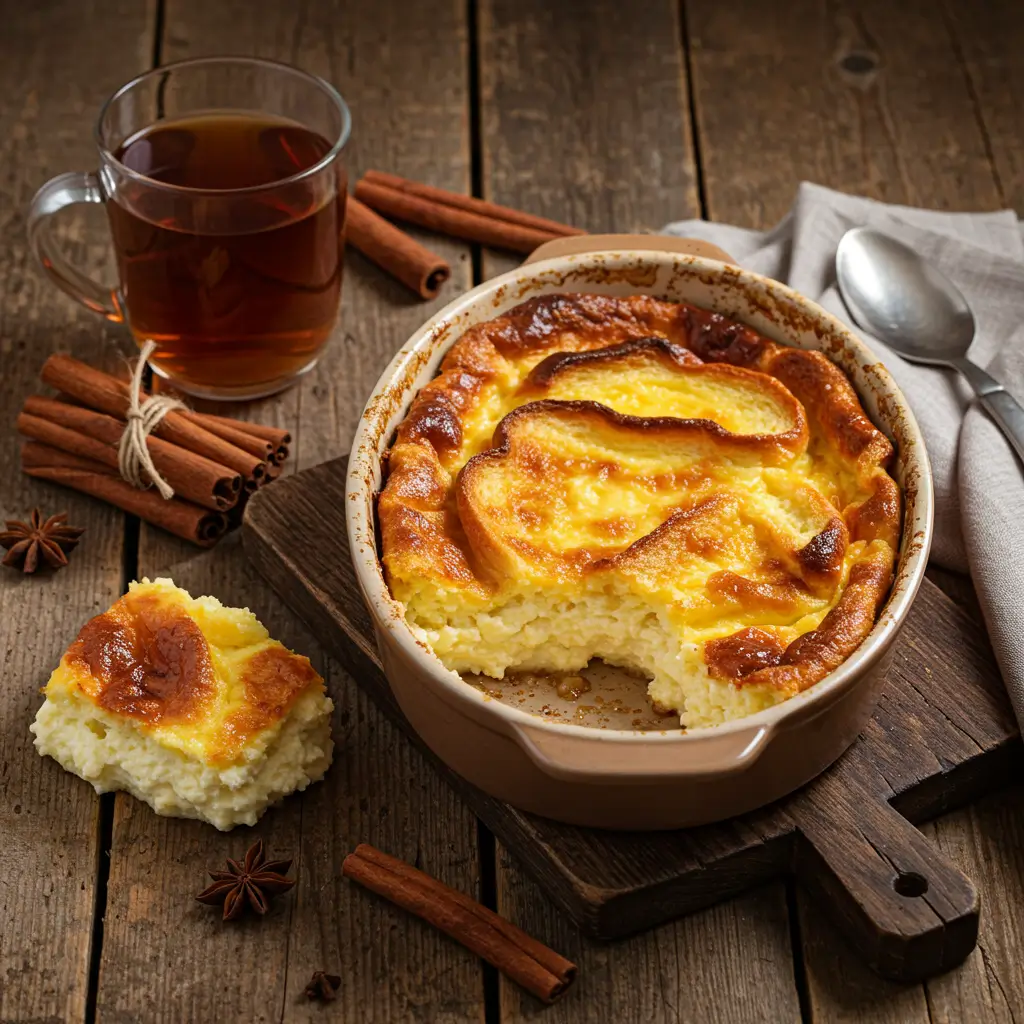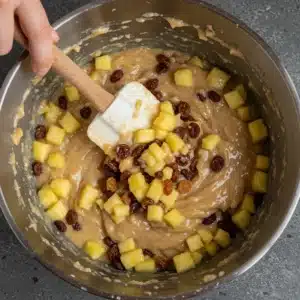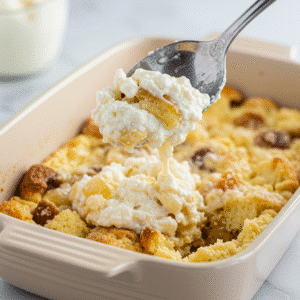
Looking for a cozy dessert that’s creamy, comforting, and packed with protein? This cottage cheese bread pudding hits every note. With wholesome ingredients and simple prep, it’s the perfect mix of nutrient-dense and nostalgic. Whether you’re already a cottage cheese fan or just curious about how it can transform your desserts, you’re in the right place. I’ll walk you through how to make this incredibly easy, affordable, and satisfying treat for breakfast, dessert, or any time in between. And I’ll even share my favorite flavor upgrades to make it your own.
Table of Contents
Table of Contents
A Comfort Dish Born from My Cottage Cheese Journey
A Humble Cottage Cheese Beginning
I first stumbled upon cottage cheese bread pudding by accident. Back in college, I was living off a tight budget and experimenting with ways to make high-protein meals that didn’t require grilling chicken every night. I had a giant tub of cottage cheese, some crusty sourdough ends, and a moral objection to wasting food. You see where this is going.
Let me be real: my first try was awful. I poured cold cottage cheese over torn-up bread and sprinkled cinnamon like I was making a toddler’s art project. Without eggs, sweetener, or structure, it was a soggy, sad mess. But I didn’t give up. I learned what made bread pudding work: balance. Custard needs eggs, the bread needs to soak, and texture is everything. Over time, I refined the recipe into something creamy, sweet-but-not-cloying, with a golden top and custardy bites. It became more than just a student meal, it was my introduction to comfort food that’s actually healthy.
Why Bread Pudding is the Perfect Comfort-Food Twist
Now, as a nutritionist helping busy families, I get excited when tradition meets smart nutrition. Cottage cheese bread pudding lets me do exactly that. The cottage cheese adds a mild tang and serious protein punch that keeps my clients feeling full longer, and parents love it because their kids think it’s dessert.
Plus, it’s endlessly customizable banana for creaminess, berries for tartness, even pumpkin spice for the holidays. I often include this recipe in client meal plans under “higher-protein desserts” linked to others like this cottage cheese desserts roundup that don’t spike blood sugar like traditional sweets. For readers who think “cottage cheese in dessert?” sounds a little odd, I’ve been there. But trust me, this one’s a keeper.
Cottage cheese is low in calories while providing protein and vital nutrients, making it one of the healthiest cheeses you can eat.(1)
Print
Cottage Cheese Bread Pudding
- Total Time: 1 hour 35 minutes
- Yield: 6 servings
Description
A creamy, protein-packed bread pudding made with cottage cheese, eggs, and wholesome bread for the perfect balance of comfort and nutrition.
Ingredients
- 2 cups cottage cheese (full-fat recommended)
- 4 cups day-old bread (sourdough, challah, or whole grain)
- 3 large eggs
- 1 1/2 cups milk (dairy or dairy-free)
- 1/3 cup maple syrup or honey
- 1 tsp vanilla extract
- 1 tsp ground cinnamon
- Optional: 1/2 cup raisins, chopped fruit, or chocolate chips

Instructions
- Preheat the oven to 350°F (175°C) and grease an 8×8 baking dish.
- In a blender, combine cottage cheese, eggs, milk, maple syrup (or honey), vanilla, and cinnamon until smooth.

- Place the bread cubes in a large bowl and pour the blended mixture over them. Stir to coat evenly and let soak for at least 30 minutes.
- Fold in any optional add-ins like raisins, fruit, or chocolate chips.

- Transfer the mixture into the prepared baking dish and spread evenly.

- Bake for 45–55 minutes, until the top is golden brown and the center is just set.
- Let rest for 10 minutes before serving. Enjoy warm or chilled with your favorite toppings.
Notes
For a dairy-free version, use plant-based cottage cheese and almond or oat milk. For gluten-free, substitute with your favorite crusty gluten-free bread. Tastes great warm or cold and stores well for meal prep.
- Prep Time: 15 minutes + 30 minutes soak
- Cook Time: 50 minutes
- Category: Dessert
- Method: Baked
- Cuisine: American
Smart Ingredients That Make Cottage Cheese Bread Pudding Work
What You Need for Cottage Cheese Bread Pudding
The best part about cottage cheese bread pudding is that it uses ingredients most of us already have in the fridge or pantry. Traditional bread pudding calls for milk, eggs, and day-old bread—but using cottage cheese adds protein and creaminess that takes it to another level.
Here’s a typical grocery list for this recipe:
- Cottage cheese (full-fat works best for texture)
- Day-old bread (sourdough, challah, whole grain)
- Eggs (to bind and build custard)
- Milk (dairy or dairy-free)
- Vanilla extract & cinnamon (for natural flavor)
- Maple syrup or honey (a natural sweetener that adds moisture)
- Optional: raisins, chopped fruit, or chocolate chips
I’m always amazed by how cottage cheese binds and softens the pudding during baking, turning rustic bread into a spoonable, luscious dish. It’s an easy way to sneak in nutrition without losing the “comfort food” feel. For an even creamier texture, I blend the cottage cheese into the milk mixture no lumps, just smooth custard.
Swap It: Making It Dairy-Free or Gluten-Free
If you’re cooking for someone with dietary restrictions, no need to skip the pudding. A few small tweaks can make your cottage cheese bread pudding completely dairy-free or gluten-free.
Instead of dairy milk, you can use unsweetened almond or oat milk, it mixes well with the cottage cheese and still yields a creamy texture. For the cottage cheese itself, dairy-free alternatives are on the market now made from cashew or almond bases. Just make sure it’s not overly watery; consistency is key.
For gluten-free diets, simply use your favorite crusty gluten-free bread. I love using a seeded loaf, it adds texture and fiber without disturbing the pudding’s soft, creamy mouthfeel. And if you’re reducing sugar? Swap maple syrup or honey with mashed banana or dates for a fruit-sweetened punch.
If dessert-friendly, protein-packed recipes like this are your thing, you’ll also want to check out my cottage cheese ice cream recipe. It’s another guilt-free way to enjoy your sweets while sneaking in real nutrition.
Step-by-Step Method That Anyone Can Master
Soaking: Don’t Skip This Step
Soaking is the one step you absolutely can’t rush if you want silky, custard-like results. After blending or whisking together your wet ingredients eggs, cottage cheese, milk, vanilla, sweetener, and spices it’s time to pour the mixture over your bread and let it sit. Ten minutes? Not enough. You’ll want to give it at least 30 minutes to fully absorb.
Think of it like marinating. This waiting period allows every chunk of bread to soak up that flavorful, creamy mixture so it bakes evenly and comes out with a pudding-like consistency not dry, not soggy. Giving the bread time to soak means richer flavor and a tender texture inside. A great rule: the denser the bread, the longer the soak.
Layer, Bake, and Let It Sit
Once your bread is fully soaked, gently fold in any add-ins: blueberries, walnuts, dark chocolate chips whatever suits your taste. Transfer the mixture to a greased 8×8 baking dish or parchment-lined tin, spreading it evenly. Bake at 350°F (175°C) for 45 to 55 minutes, or until the top is golden brown and the center feels just firm to the touch.
Let it rest for 10 minutes before serving. Fresh from the oven, it’ll have a perfectly soft middle with a caramelized top layer that’s just slightly crisp. You can top it with Greek yogurt, warmed fruit compote, or a drizzle of maple syrup for that brunch-worthy finish.
Want another oven-friendly option with cottage cheese? Try my savory spin with cottage cheese muffins a great make-ahead protein snack that’s freezer-friendly and picky-eater approved!
Flavor Variations, Perfect Pairings & Storage Tips
Make It Berry, Chocolate, or Apple Cinnamon
Once you’ve nailed the basic cottage cheese bread pudding recipe, it becomes your canvas. You can take this healthy comfort food in a million delicious directions. One of my favorites? Apple cinnamon swirl—it tastes like fall in every bite. Just stir in diced apples sautéed in cinnamon and a touch of coconut oil before baking.
If you’re in the mood for something refreshing, toss in a handful of blueberries or raspberries. These juicy, tart additions cut beautifully through the richness of the custard. You can even go full dessert mode with dark chocolate chips and a sprinkle of sea salt on top.
These tweaks don’t require changes to the core recipe—just fold them in before baking. It’s fuss-free and totally flexible. I love sharing ideas like these with clients to help them personalize their healthy treats. For something even lighter and mousse-like, my cottage cheese mousse is another simple dessert you can whip up in minutes.
Serving Warm or Cold + Storage
Cottage cheese bread pudding is one of those rare dishes that tastes just as good the next day—maybe better. Fresh out of the oven, it’s gooey and crisp-topped. But chilled overnight? It becomes denser and almost cheesecake-like. I’ve even served it cold topped with stewed berries and a dollop of yogurt for breakfast, and nobody guessed it started as dessert.
To store, wrap tightly and refrigerate for up to 4 days. Want to make ahead? No problem. You can portion it into glass containers for breakfast meal prep or freeze leftovers for up to two months. Just reheat gently in the microwave or oven.
Research suggests that people who eat protein-rich bedtime snacks like cottage cheese enjoy better muscle quality and higher metabolism. (2)
FAQ Section:
Is cottage cheese bread pudding good for weight loss?
Yes! Made with the right ingredients, cottage cheese bread pudding can be a weight-loss-friendly dessert. Cottage cheese is rich in protein and low in carbs, which helps keep you full longer. Use a natural sweetener like maple syrup or bananas and whole grain bread for added fiber.
Can I use low-fat cottage cheese in bread pudding?
Absolutely. Low-fat cottage cheese works well in this recipe and still offers creamy texture when blended. That said, full-fat provides better richness and mouthfeel. If you’re counting calories, low-fat cottage cheese is a lighter swap that won’t compromise your results.
How do I make bread pudding less soggy?
The key is in the soak and the bake. Soak the bread long enough to absorb the custard, but not so long that it disintegrates. Then bake until the top is golden and the center slightly jiggly but not wet. Let it rest 10 minutes before serving to set.
What type of bread works best for cottage cheese pudding?
Stale, crusty breads like sourdough, challah, brioche, or whole grain work beautifully. They hold their structure after soaking and deliver texture. Avoid soft sandwich bread—it tends to turn mushy. Day-old or toasted bread is your best bet.
Conclusion
Cottage cheese bread pudding is much more than a cozy dessert; it’s a smart solution for healthier indulgence that fits every lifestyle. Whether you’re baking for brunch, prepping ahead for breakfast, or craving dessert without the crash, this comforting dish has your back. Packed with protein, endlessly customizable, and unbelievably easy—this is one recipe you’ll turn to again and again. Even cottage cheese skeptics? They’ll ask for seconds.




